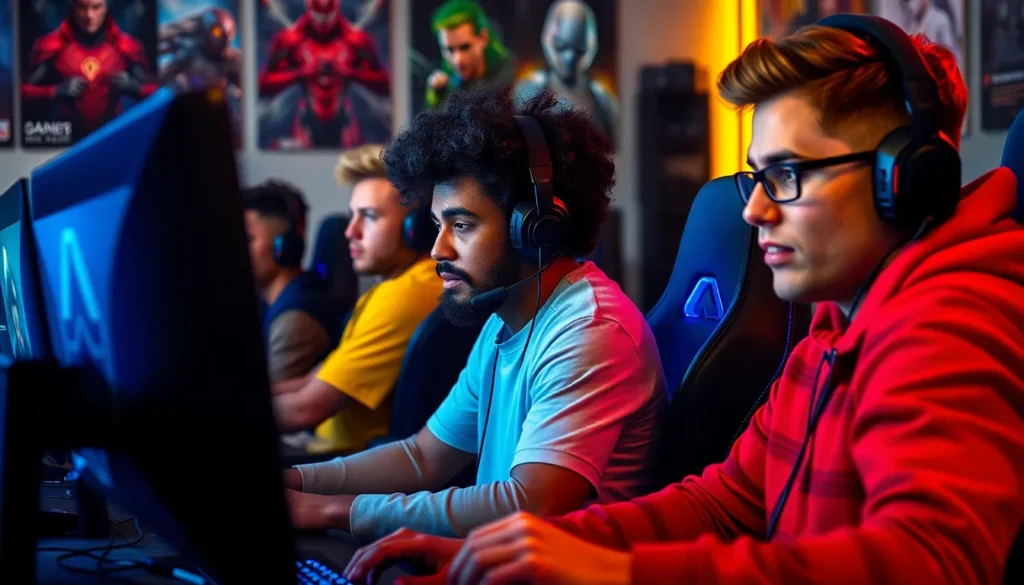In the world of competitive gaming, the Crucible ranking system stands as both a badge of honor and a source of endless debates among players. It’s the ultimate playground where skill meets strategy, and every match can either catapult a player to glory or send them spiraling back to the depths of matchmaking despair. Imagine a rollercoaster ride where the highs feel exhilarating and the lows leave you questioning your life choices—welcome to the Crucible!
Table of Contents
ToggleOverview of Crucible Ranking System
The Crucible ranking system serves as a pivotal framework within competitive gaming. This system evaluates player performance through a structured method.
Purpose of the Ranking System
The ranking system aims to match players of similar skill levels for fair competition. It assists in providing measurable goals and rewards for players seeking improvement. This structure encourages players to hone their strategies, enhancing overall gameplay. Rankings reflect individual and team progress, fostering a sense of achievement. Players can also identify their strengths and weaknesses through this feedback, improving their future performances.
Key Components of the System
Several key components define the Crucible ranking system. Matchmaking algorithms assess player skill and adjust rankings according to performance metrics. Skill tiers categorize players, allowing for organized competition across diverse levels. Points earned through victories or losses directly impact a player’s rank, creating a dynamic ranking environment. Additionally, seasonal resets keep the competition fresh, incentivizing players to continually engage and improve. This framework ensures ongoing evolution in rankings, maintaining an engaging competitive atmosphere.
How the Crucible Ranking System Works

The Crucible ranking system evaluates player performance through specific criteria and an effective evaluation process.
Ranking Criteria
Skill tiers represent a player’s ability, grouping competitors into categories such as Bronze, Silver, Gold, and Platinum. Match outcomes determine rank progression; wins result in points, while losses can decrease a player’s standing. Players achieve higher ranks by demonstrating consistent performance and teamwork in matches. Individual contributions, such as objective captures and eliminations, significantly influence these rankings. Player statistics and achievements drive personalized rankings, providing a clear pathway for improvement.
Evaluation Process
Developed through advanced matchmaking algorithms, the evaluation process assesses player performance. Each match yields data on player actions, behavior, and collaboration. Analyzing this data helps create a fair ranking adjustment that reflects true skill levels. Seasonal resets refresh the ranking landscape, ensuring players remain competitive throughout their journey. Players receive feedback after matches, informing them about areas for growth and potential strategies. This structured approach balances competitiveness with opportunities for enhancement, promoting sustained engagement within the Crucible community.
Advantages of the Crucible Ranking System
The Crucible ranking system provides multiple advantages that enhance the competitive gaming experience for players. It fosters growth and engagement through a structured framework.
Improved Performance Metrics
Performance metrics enhance player evaluation significantly. Players receive detailed feedback on their match contributions, such as objective captures and eliminations. Metrics reflect individual efforts, creating opportunities for targeted improvement. Tracking progress over time enables players to identify strengths and weaknesses. Structured performance data serves as a roadmap toward skill enhancements. Understanding one’s capabilities leads to informed decisions in gameplay and strategy.
Enhanced Competition
Competition becomes more intense with a well-structured ranking system. Players compete against others of similar skill levels, creating balanced matches. Fair competition encourages players to push their limits and refine their strategies. Engaging in close matches leads to greater satisfaction and excitement. Regular seasonal resets maintain a dynamic environment, continuously motivating players. Thriving in a challenging landscape promotes a vigorous community spirit. Overall, the enhanced competition drives both individual and collective improvement among players.
Limitations of the Crucible Ranking System
The Crucible ranking system, while effective, does have limitations impacting its credibility and fairness.
Subjectivity in Rankings
Subjectivity can influence player rankings significantly. Player contributions to matches, like eliminations or objectives, often rely on interpretation. Different players might assess performance variances and achievements distinctly. This inconsistency can lead to frustration for those feeling undervalued in rankings. Furthermore, subjective elements, such as personal biases, can affect a player’s perceived skill level. Players might perceive rank discrepancies as unfair, particularly when performance evaluations seem inconsistent. This phenomenon provokes discussion among community members regarding the true accuracy of the ranking system.
Potential for Gaming the System
Gaming the system poses another critical concern. Players may exploit loopholes in the ranking structure for quick rank advancements. Techniques like deliberately losing matches or grouping with lower-ranked friends distort the intended competitive integrity. Such strategies can undermine the experience for more dedicated players engaged in fair play. Recognizing this flaw, developers consistently adapt matchmaking algorithms to diminish such exploitation. Nevertheless, the potential for manipulation remains a consistent challenge within the competitive landscape. Ultimately, maintaining a balanced ranking environment requires ongoing monitoring and adjustments from the developers.
Future of the Crucible Ranking System
The Crucible ranking system is poised for significant evolution. Players can anticipate enhancements across various features that cater to skill assessment and matchmaking.
Expected Developments
Developers focus on refining matchmaking algorithms to ensure fairer placements. Players may experience improved feedback mechanisms that highlight individual contributions more accurately. Enhanced performance metrics could offer deeper insights into gameplay, empowering players to strategize effectively. Seasonal resets might implement new challenges to rekindle interest while keeping the competitive landscape dynamic. All these potential updates aim to foster an engaging environment that motivates ongoing player participation.
Community Feedback
Community input plays a critical role in shaping the Crucible ranking system’s future. Players often express concerns regarding fairness and clarity in ranking determinations. Ongoing discussions about subjective evaluation criteria could lead to better transparency and adjustments in structure. Regular surveys and forums provide platforms for players to share experiences and suggestions. Incorporating this feedback helps developers identify areas needing improvement, reinforcing the system’s integrity and player satisfaction.
The Crucible ranking system remains a vital aspect of competitive gaming. It not only challenges players to improve their skills but also fosters a community centered around shared experiences. While it offers a structured framework for fair competition, the ongoing debates about its credibility and fairness highlight the need for continuous refinement.
As developers work to enhance matchmaking algorithms and feedback mechanisms, players can expect a more balanced and engaging competitive environment. The future of the Crucible ranking system looks promising, with a focus on community input and innovative changes that aim to elevate the gaming experience. Embracing these developments will empower players to thrive and enjoy the journey through the ranks.





